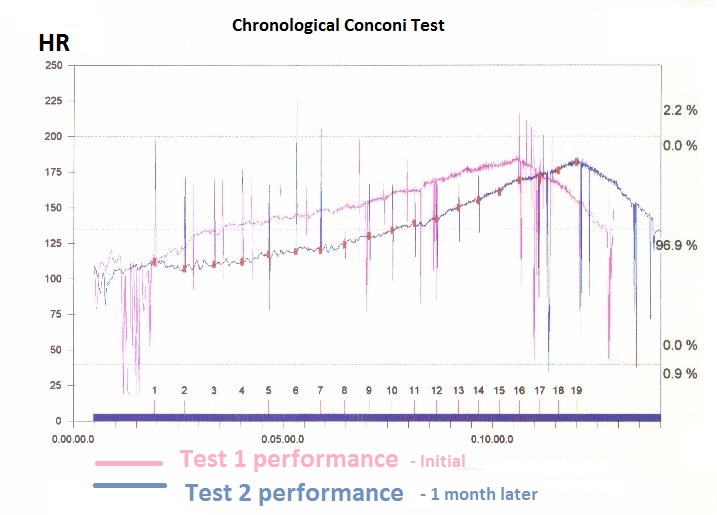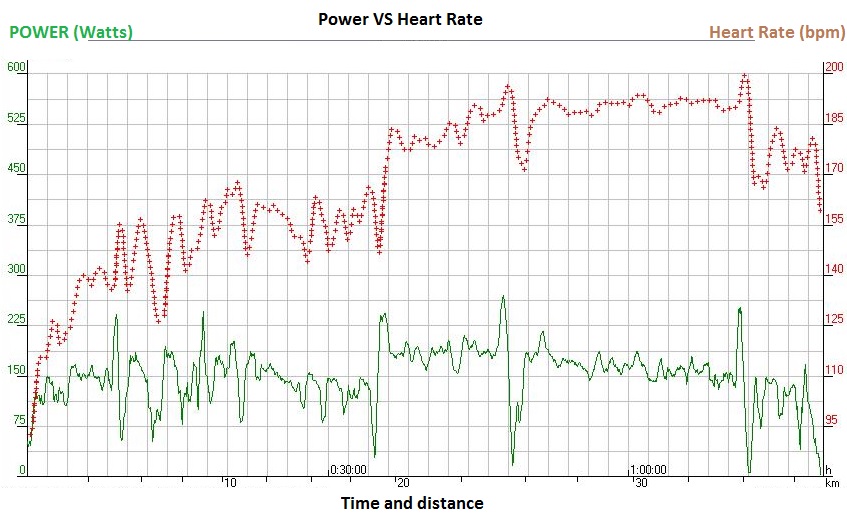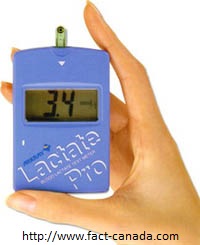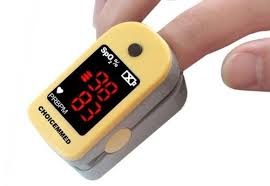PERFORMANCE
TESTING
When you are training,
goal setting is usually the best way to set up a plan to
achieve improvements.
Increasing miles, training periods, bricks, and overall exercise
time is the key to stretch your current fitness and go to the
next level. That means, also, being able to baseline and quantify your
current level of fitness so you can measure the improvements you
achieve over time. Record
your initial abilities and then compare them to your current
set. The gap is your improvement.
However, improvements can be difficult to
quantify. Subjectively we can feel if we are going faster - we
hang with the group; we lead a breakaway; we achieve a personal
best. But rather than one day saying "I averaged 3 mph
faster" and the next day blame it on the wind for a slower pace,
you can set up performance indicators to normalize and
quantify your progress.
How do you quantify performance? How are performance indicators
set up?
Performance Indicators are determined with periodic performance
testing.
| Testing allows you to collect a chronological set of
parameters of your abilities that you can use to compare
to each other. How do you perform today as compared to
last month? Last quarter; 6 months ago; a year ago? |
 |
Periodic performance testing allows you to quantify
this progress by measuring a standard set of performance
indicators that are normalized and repeatable.
If you work with a trainer or a coach, you are likely on a
program called interval training.
Probably, you are familiar with it. And, probably, you
already do interval training. It's a well-known, common practice
to do sets of a specific activity: an interval. Obscure words
like Lactate Threshold, Lactic Acid Threshold, Anaerobic
Threshold and Functional Power Threshold, along with even more
technical terms like VO2MAX have made it into the everyday
vocabulary of most cyclists and athletes in general.
LT/FTP is the most important training parameter for training.
Training at LT/FTP literately changes the bio-chemistry of an
athlete's body, making it more efficient, able to sustain more
power, for longer periods of time. And it's great for weight
loss.
The knowledge of this proper training
methodology has trickled down to the everyday cyclist. And so,
you are out there
working hard on your LT/FTP intervals and VO2MAX - blind!
Why do we say blind? Because most of us "guestimate"
how to perform those intervals. For as long as we are working
hard, we are confident that we are making improvements.
But... Are we really?
|
Doing an interval using the feeling in your legs as the
standard for the level of exertion -or to near exhaustion- is not
exactly very scientific. And, for sure, not
normalized and repeatable. One day you feel good
and can go hard, the next you don't sleep quite well and your
performance suffers. Ups and downs are normal. But training
this way - going hard, without a specific target - is a
blind effort, hoping it would work.
Now imagine... Your coach tells you to do a
set of LT intervals at a
specific heart rate for 20 min; or a FTP intervals at a
specific power AKA Wattage for 25 minutes. No matter how you feel, you
know what you have to do. You turn on your heart rate monitor or
power meter and off you go training with a specific goal. Now... this is
normalized and repeatable...
|
 |
Normalizing your training.
How does your coach know what specific intensity
levels to choose for you? Performance Testing.
How do you do performance testing?
There are a few methodologies, but the most commonly agreed upon
and used by most athletes and coaches is LT/FTP testing as
follows:
- Find an open stretch of road that you can ride without
interruptions for 30 mins. 2% uphill grade and no wind is
advisable to get normalized results.
- Warm up. Do a couple of short and high intensity intervals 2-3
mins to get the legs going and jump start the lactic acid
process.
- Do a 30 min Time Trial as hard as you can. Record Heart Rate
and Power (if possible).
- Your LT/FTP will be the stable HR or Wattage
Sounds reasonable, right? Other than... Where do we find such a
road with a steady 2% grade, no stop signs, no traffic and no
wind -once a month?
If you live in Florida, you know, that's impossible. Or even
safe.
Enter in-studio performance testing.
|
With properly set up equipment/software and a professional-grade
power meter like the CompuTrainer Ergometer, this process can be
made simple, safe and -most importantly- normalized
and repeatable.
Using the Computrainer software and a function called the
Conconi test, a cyclist is set up for a Time Trial interval
where the computer progressively imposes higher loads on the
rider, while tracking his/her heart rate and power output. The
built-in software logs data and the response to each new load
every second during the test. At the end of the test, algorithms
within the software use all the logged data to compute your
LT/FTP.
|
 |
It's 30 minutes of pure bliss. Unadulterated, pure, all-out
effort that tells the story of you: your past training; your
current fitness level and your future goals.
For endurance athletes, LT/FTP testing is the holy grail of
performance.
Another key performance parameter for training is VO2MAX.
It measures your ability to bring vital oxygen into your system
-and by association, the delivery it to the muscles.
VO2MAX is a key parameter of your aerobic ability: it's the max
amount of oxygen that you can use at max level of effort. It's a
great companion test to LT/FTP and it gives an indication of the
cardiovascular fitness of an athlete. LT/FTP is usually 60-85%
or VO2MAX. But while FTP/LT is more easily improved, VO2MAX has
a genetic component that limits the max an individual can ever
achieve. For this reason, it's an important parameter, as most
athletes want to reach their max genetic VO2 and maintain it,
while further stressing the LT/FTP.
| VO2MAX is strictly lab environment testing. It
requires equipment to read the amount of oxygen in the
blood. It's measured in
milliliters of oxygen used in one minute per kilogram of
body weight (ml/kg). Sounds more complex than it really
is.
In essence, the equipment measures
the amount of oxygen intake over a period of time while
exercising at max effort. It's a hard, short and all-out
effort. You push to the max of your abilities.
Accurately measuring the oxygen
intake is they key to the success of this testing and
can be a little tricky.
Sometimes an oxygen mask is
used - but that can taint results as it can constrict
the flow of oxygen. We most certainly felt as if
it restricted our natural ability to get oxygen into our
lungs, like breathing through a big straw. |
 |
|
Sometimes blood samples are taken at intervals
during an all out effort. The samples are tested in an
equipment similar to glucometers for diabetes testing. A small
blood droplet is sampled on a lancet that is inserted in the
reader.
It's rather accurate in measuring the blood
oxygen levels, but it can be difficult to administer in a timely
fashion. cyclists tent to move a bit during hard efforts. It
also requires several samples so that an average can be
computed. Some athletes may not like being poked so much.
|
 |
| More recently, less invasive finger cuffs can be used to read
blood oxygen levels accurately (similar to what hospitals use).
These units use infrared spectrometry refraction to
bounce a signal off the cells in your blood. Easy to
wear, easy to administer, this is the way of the future. |
 |
Combining LT/FTP and VO2MAX periodic testing, allows you to set
up the baseline from which to train. With this information, your coach will
set up your training zones and break down
your regimen in training blocks, alternating
periods of building with resting. At the end of each training
block, performance testing becomes the all-important
quantification of the progress and the starting point from which
to build on the next block.
For example, you tested your FTP at 245W with an average HR of
175 bpm at the beginning of your training block. Your coach has
given you intervals ranging from 60% to 120% of the FTP for your
first building block of 4 weeks.
At the end of the training block, you test again. Now your FTP
is 310W at 175 bpm. This becomes the base for your next interval
training block. New training zones are computed and a new set of
interval training is prescribed in these zones.
This process is repeated until you reach your
max potential given the
time you can invest in your training and the effort you are
capable of producing. At this point, you go into lifetime
best maintenance mode and performance testing takes on a
different meaning: overtraining prevention.
We can't always maintain the same level of fitness. And if we
push too hard for too long, we just reach a point of exhaustion.
Also, life has a habit of getting in the way: winter, work, children,
injuries, illness, etc.
When you have a well-established lifetime
best LT/FTP,
performance testing helps you do just what you need to do and no
more. Saves you time and energy for the other things in life you
have to tend to. And, more importantly, it helps you in recognizing if and
when you are trying too hard - driving yourself into the ground
with no gain. Or if it's time to get back on the horse, after a
period of recovery.
Training is a cat and mouse game with your own fitness. Consider the
addition of performance testing to your training regimen as the edge
for staying always at
your best, given your current situation.
OUR BELIEF:
"You don't have to be a Pro to get a bike fit. Everyone who
climbs into a bike deserves to have a great experience,
regardless of their fitness, expertise or equipment level."
A Perfect Bike Fit Pro Studio
Love your ride. Get a bike fit.